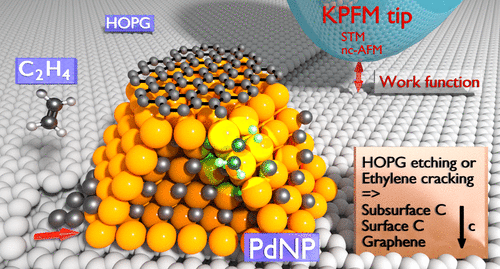当前位置:
X-MOL 学术
›
J. Phys. Chem. C
›
论文详情
Our official English website, www.x-mol.net, welcomes your
feedback! (Note: you will need to create a separate account there.)
Revealing Carbon Phenomena at Palladium Nanoparticles by Analyzing the Work Function
The Journal of Physical Chemistry C ( IF 3.3 ) Pub Date : 2019-02-13 , DOI: 10.1021/acs.jpcc.8b12208 Henrik Grönbeck 1 , Clemens Barth 2
The Journal of Physical Chemistry C ( IF 3.3 ) Pub Date : 2019-02-13 , DOI: 10.1021/acs.jpcc.8b12208 Henrik Grönbeck 1 , Clemens Barth 2
Affiliation

|
Carbon at metal nanoparticles (NPs) plays a fundamental role in heterogeneous catalysis. However, as experimental detection of small amounts of carbon is difficult, in particular when occupying subsurface sites, reaction mechanisms involving absorbed carbon are highly debated. Here, we show that the work function (WF) of metal NPs can be used as a measure of carbon adsorption and absorption, which we demonstrate by Kelvin probe force microscopy and density functional theory calculations for (111)-faceted palladium NPs (PdNPs) on graphite. Growth of PdNPs between 150 and 480 °C leads to carbon etching of the graphite steps and carbon absorption into the first subsurface layer below the NP’s facets. This strongly reduces the WF of Pd(111) by up to −1 eV. During a 1 h long postannealing at 650 °C, more carbon is etched from the graphite steps, leading to a carbon precursor structure adsorbed on the NP’s facets, as verified by scanning tunneling microscopy. The carbonaceous structures are replaced by graphene upon further annealing (1 to 2 h), followed by a decrease in the WF by ∼−1.4 eV. Similar phenomena are observed after short-time ethylene decomposition at PdNPs at 650 °C. Apart from subsurface carbon, we suggest that the large WF shifts observed experimentally could be attributed to structural defects on NP’s facets.
中文翻译:

通过分析功函数揭示钯纳米颗粒上的碳现象
金属纳米颗粒(NPs)上的碳在非均相催化中起着基本作用。然而,由于很难检测到少量的碳,特别是在占据地下位置时,涉及吸附碳的反应机理受到了广泛的争议。在这里,我们表明金属NP的功函数(WF)可以用作碳吸附和吸收的量度,我们通过Kelvin探针力显微镜和密度泛函理论计算证明了(111)面钯NP(PdNP)在石墨上。PdNP在150至480°C之间的生长会导致石墨台阶的碳蚀刻以及碳吸收到NP小平面下方的第一地下层中。这将Pd(111)的WF大大降低了-1 eV。在650°C下进行1小时的长时间退火后,石墨台阶会蚀刻出更多的碳,导致碳前驱体结构吸附在NP的表面上,这已通过扫描隧道显微镜进行了验证。在进一步退火(1-2小时)后,碳素结构被石墨烯取代,随后WF降低了约-1.4 eV。乙烯在650°C的PdNP下短时间分解后,观察到类似现象。除了地下碳,我们建议实验观察到的大的WF位移可能归因于NP表面的结构缺陷。
更新日期:2019-02-14
中文翻译:

通过分析功函数揭示钯纳米颗粒上的碳现象
金属纳米颗粒(NPs)上的碳在非均相催化中起着基本作用。然而,由于很难检测到少量的碳,特别是在占据地下位置时,涉及吸附碳的反应机理受到了广泛的争议。在这里,我们表明金属NP的功函数(WF)可以用作碳吸附和吸收的量度,我们通过Kelvin探针力显微镜和密度泛函理论计算证明了(111)面钯NP(PdNP)在石墨上。PdNP在150至480°C之间的生长会导致石墨台阶的碳蚀刻以及碳吸收到NP小平面下方的第一地下层中。这将Pd(111)的WF大大降低了-1 eV。在650°C下进行1小时的长时间退火后,石墨台阶会蚀刻出更多的碳,导致碳前驱体结构吸附在NP的表面上,这已通过扫描隧道显微镜进行了验证。在进一步退火(1-2小时)后,碳素结构被石墨烯取代,随后WF降低了约-1.4 eV。乙烯在650°C的PdNP下短时间分解后,观察到类似现象。除了地下碳,我们建议实验观察到的大的WF位移可能归因于NP表面的结构缺陷。




















































 京公网安备 11010802027423号
京公网安备 11010802027423号